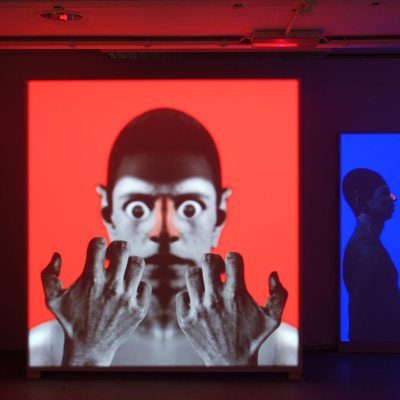For this year’s biennale the curators, DIS (New York), have corralled dozens of artists and start-up artist collectives to illustrate the alienating scale of content produced in our hyperconnected world. The biennale takes place over four main venues: the Akademie der Künste; the European School of Management and Technology (ESMT); a former telecommunications bunker that now holds the Feuerle Collection; and the KW Institute for Contemporary Art. Among the various additional platforms is a website fittingly called Fear of Content – it is a continuous feed of essays, interviews, and digital projects. Together they form what one participating collective calls a ‘hyperlinked landscape’ that permits a certain lack of attention and a sort of privileged lassitude.
Blockchain Visionaries (2016), Simon Denny with Linda Kantchev. Courtesy Simon Denny; Galerie Buchholz, Cologne/Berlin/New York. Photo: Timo Ohler

In the ESMT Simon Denny presents three stalls that seem to have been plucked directly from a payments-consultant trade fair. The stalls represent actual companies: a crypto-anarchist, a bitcoin start-up, and an asset-management company. It is expertly exhibited, but despite the evocative siting (the ESMT was once the East German State Council) it barely moves beyond the informative.
MINT (2016), Debora Delmar Corp. Courtesy Debora Delmar Corp.; Duve, Berlin. Photo: Timo Ohler

On the ground floor of the corporate-looking Akademie der Künste there is a juice bar titled Mint (2016) by Mexican artist Debora Delmar Corp. Here you can purchase a juice, sit at a bench fashioned from repurposed timber pallets and observe the bar’s large pseudo-ironic corporate images and the fake plants while, presumably, enjoying the irony. Upstairs, Christopher Kulendran Thomas’s installation New Eelam (2016) at once suggests (with a strange sense of datedness) a reception area, a boutique hotel lobby, and a sales apartment. A flatscreen on one of the walls plays an advertisement for a company called New Eelam that purports to alleviate housing shortages by ‘streaming homes’ for those who choose to partake in its ‘liquid citizenship’. The video work is slickly hammy, to the point of undermining the more interesting oddness of the rest of the installation. This microcosm illustrates something about the biennale generally, because one has to wonder what might have been, had the organisers held more closely to their curatorial vision and permitted no lapses into the recognisable world of contemporary art presentation at all. Perhaps then the cool flatness of the proposal may have gained some strange overall aesthetic traction. Instead the artworks interspersed nervously throughout come off as inappropriately earnest within the iDystopianism that is trying to take hold around them.
New Eelam (2016), Christopher Kulendran Thomas. Courtesy Christopher Kulendran Thomas; New Galerie, Paris. Photo: Timo Ohler

In the KW Institute the works on show, with some exceptions, sit between bombast and affected disinterest. Cécile B. Evans’s large installation work comprises a cinema screen on the rear wall of the space, onto which are projected various film works about ‘emotion [and memory] in contemporary society’. To the front is a walkway around which water ripples, and placed within this body of water is a series of plinths that hold abstract holograms reminiscent of ’90s video games. The work, shrouded in darkness, gets its validity from how ingeniously it has incorporated current fashions in art: it looks like a cross between a mock altar, and a rock concert.
What the Heart Wants (2016), Cécile B. Evans. Courtesy Cécile B. Evans; Galerie Emanuel Layr, Vienna; Barbara Seiler, Zurich. Photo: Timo Ohler

Though it may claim otherwise, this biennale is an inward-looking one, focused on exposing the machinations of contemporary art when the rate of technical innovation has overtaken the rate of production of fashions, which itself has long overtaken the rate at which critical thought can gather around these changes.
The 9th Berlin Biennale for Contemporary Art runs until 18 September.



